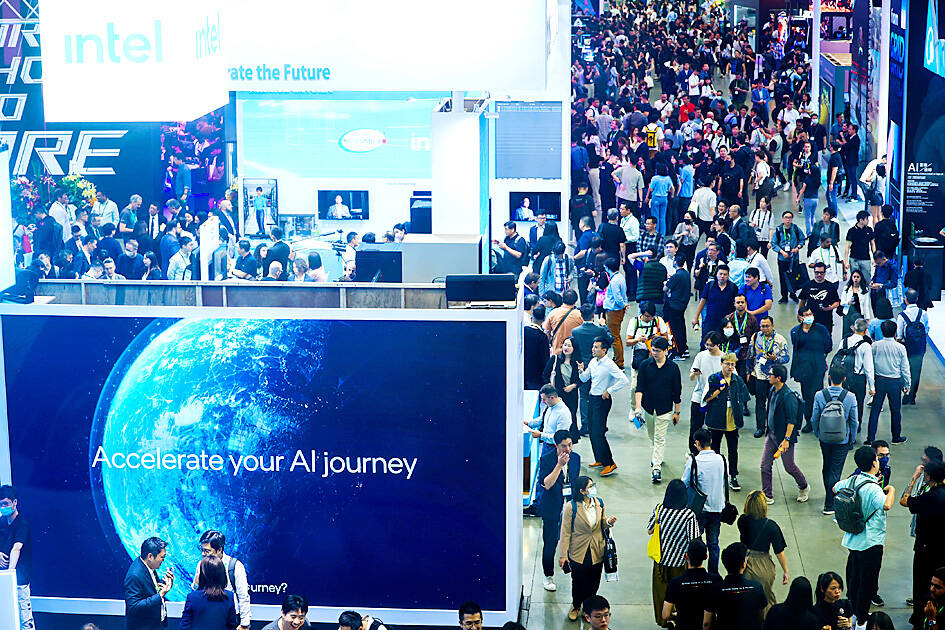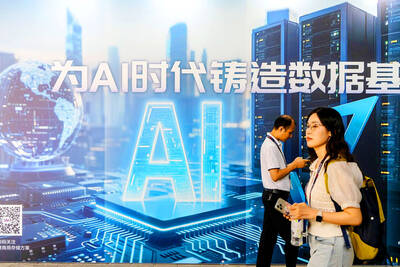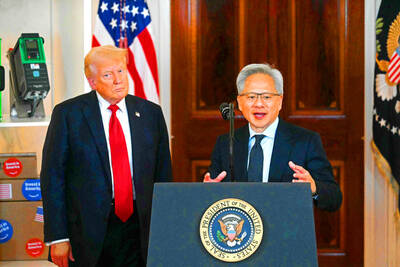The Computex trade show opens this week in Taipei, and as in years past would draw industry chieftains such as Nvidia Corp CEO Jensen Huang (黃仁勳), Qualcomm Inc CEO Cristiano Amon and Hon Hai Precision Industry Co (鴻海) chairman Young Liu (劉揚偉).
While last year’s event was a celebration of the post-ChatGPT artificial intelligence (AI) boom, executives this year are likely grappling with the uncertainty of the administration of US President Donald Trump’s effort to reshape the global trade order — disrupting a decades-old model for tech manufacturing.
The exhibition would of course feature the hardware required to bring AI to life. Apart from Nvidia chips, that includes server racks assembled by Hon Hai, also known as Foxconn Technology Group (富士康), power components from Delta Electronics Inc (台達電) and datacenter cooling systems from Asia Vital Components Co (奇鋐). While they tout new products onstage, these companies are also confronting profound questions about the US administration’s tariff regime.

Photo: CNA
SHIFTING GEOGRAPHY
Trump wants manufacturing back home. To that end, the White House has secured major chipmaking commitments, most notably an additional US$100 billion investment from Taiwan Semiconductor Manufacturing Co (TSMC, 台積電). As TSMC builds out its Arizona operations with more production lines, supply chain players are also joining it in the US — and accelerating those plans because of the new tariffs.
Asia’s biggest electronics companies might also find new opportunity in the Middle East. In the week before Computex, a US delegation led by Trump visited Saudi Arabia’s Riyadh with lofty promises of new trade deals. Alongside a relaxation of AI chip export rules, the visit underlines the Middle East’s growing importance as a player in the AI field.
“The new focus on export rules around China and Huawei [Technologies Co (華為)] means more opportunity for Taiwan,” industry analyst Dan Nystedt said.
QUESTIONABLE PAYOFF
From Advanced Micro Devices Inc to Nvidia and Qualcomm, the development of generative AI was heralded at Computex last year as comparable to the advent of the Internet.
Consumers have not responded with the same enthusiasm. Smartphone shipments grew by only 2.4 percent and PCs by an even slimmer 1.8 percent over the holiday quarter, industry tracker International Data Corp (IDC) said. The promises from the likes of Samsung Electronics Co about how transformative AI would be in day-to-day life have not come to pass. Apple has not even rolled out its full AI suite for iPhones yet.
Executives at Computex would face questions about when the payoff is supposed to come and address concerns about an AI bubble.
NEW MAN IN CHARGE
Intel Corp’s new CEO Lip-Bu Tan (陳立武) would not be at Computex in a formal capacity, as the company would not conduct its traditional keynote address. However, he would likely be attending more meetings than anyone at the show, as he continues his survey of partners and customers, while working to reassure and recruit partners for the effort to close ground on Nvidia and TSMC.
“Computex is historically such a PC-focused event, and yet Intel seems to be sitting it out quietly,” IDC analyst Bryan Ma (馬伯遠) said. “It’s understandable given everything else going on in the organization right now, but their absence is notable, given all of their talk about AI PCs last year.”
FOXCONN DEBUT
Foxconn is making an unusually prominent appearance, and Liu would host a keynote presentation tomorrow, likely underscoring its growing role as an AI server assembler. At the same time, the company is working to diversify its revenue away from assembling smartphones and other consumer electronics to electric vehicles. The company is also keen on advancing robotics.
“Of course AI plus robots,” Liu has said about the focus at Computex.
NEXT FOR NVIDIA
Nvidia has been forthcoming with plans to upgrade its AI chips on a roughly annual basis, and Huang has also talked about the potential of AI in the robotics industry. Microsoft Corp’s developer event, Build, is taking place the same week, in Seattle, and speculation has grown about Nvidia joining Qualcomm in building more AI-capable, Arm Holdings PLC-based chips for PCs.
“I’m keeping my eyes and ears open for whatever Nvidia and MediaTek [Inc (聯發科)] might confirm around their rumored Windows-on-Arm solution,” Ma said. That might further challenge Intel’s traditional stronghold.

Taiwan Semiconductor Manufacturing Co (TSMC, 台積電) last week recorded an increase in the number of shareholders to the highest in almost eight months, despite its share price falling 3.38 percent from the previous week, Taiwan Stock Exchange data released on Saturday showed. As of Friday, TSMC had 1.88 million shareholders, the most since the week of April 25 and an increase of 31,870 from the previous week, the data showed. The number of shareholders jumped despite a drop of NT$50 (US$1.59), or 3.38 percent, in TSMC’s share price from a week earlier to NT$1,430, as investors took profits from their earlier gains

AI TALENT: No financial details were released about the deal, in which top Groq executives, including its CEO, would join Nvidia to help advance the technology Nvidia Corp has agreed to a licensing deal with artificial intelligence (AI) start-up Groq, furthering its investments in companies connected to the AI boom and gaining the right to add a new type of technology to its products. The world’s largest publicly traded company has paid for the right to use Groq’s technology and is to integrate its chip design into future products. Some of the start-up’s executives are leaving to join Nvidia to help with that effort, the companies said. Groq would continue as an independent company with a new chief executive, it said on Wednesday in a post on its Web

CHINA RIVAL: The chips are positioned to compete with Nvidia’s Hopper and Blackwell products and would enable clusters connecting more than 100,000 chips Moore Threads Technology Co (摩爾線程) introduced a new generation of chips aimed at reducing artificial intelligence (AI) developers’ dependence on Nvidia Corp’s hardware, just weeks after pulling off one of the most successful Chinese initial public offerings (IPOs) in years. “These products will significantly enhance world-class computing speed and capabilities that all developers aspire to,” Moore Threads CEO Zhang Jianzhong (張建中), a former Nvidia executive, said on Saturday at a company event in Beijing. “We hope they can meet the needs of more developers in China so that you no longer need to wait for advanced foreign products.” Chinese chipmakers are in

POLICY REVERSAL: The decision to allow sales of Nvidia’s H200 chips to China came after years of tightening controls and has drawn objections among some Republicans US House Republicans are calling for arms-sale-style congressional oversight of artificial intelligence (AI) chip exports as US President Donald Trump’s administration moves to approve licenses for Nvidia Corp to ship its H200 processor to China. US Representative Brian Mast, the Republican chairman of the US House Committee on Foreign Affairs, which oversees export controls, on Friday introduced a bill dubbed the AI Overwatch Act that would require the US Congress to be notified of AI chips sales to adversaries. Any processors equal to or higher in capabilities than Nvidia’s H20 would be subject to oversight, the draft bill says. Lawmakers would have